2023届高三英语二轮复习:名词,冠词和数词 课件(22张)
文档属性
| 名称 | 2023届高三英语二轮复习:名词,冠词和数词 课件(22张) |  | |
| 格式 | pptx | ||
| 文件大小 | 5.2MB | ||
| 资源类型 | 教案 | ||
| 版本资源 | 通用版 | ||
| 科目 | 英语 | ||
| 更新时间 | 2022-10-03 21:34:39 | ||
图片预览


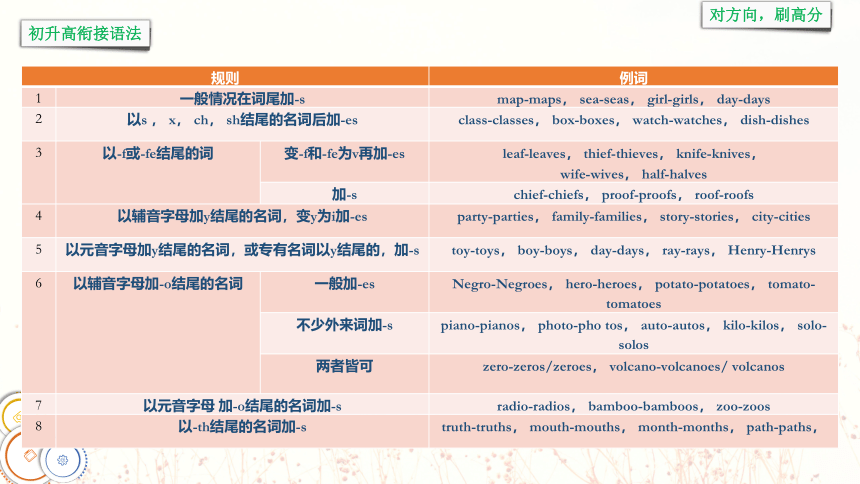

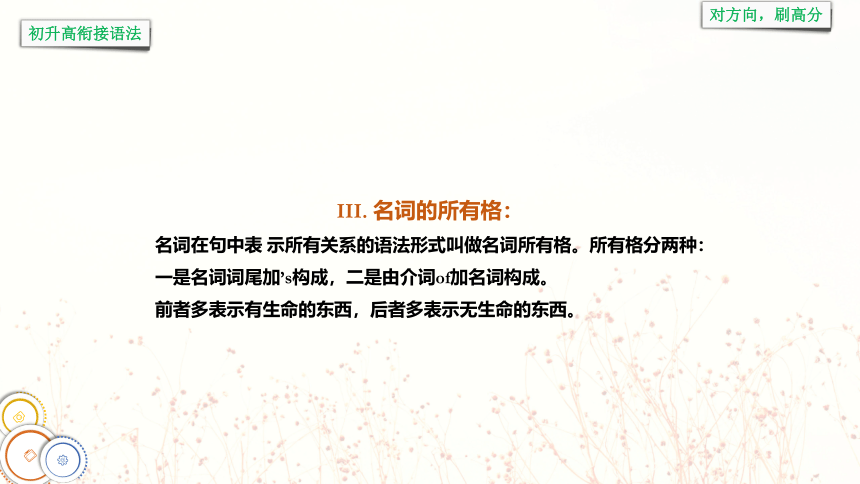
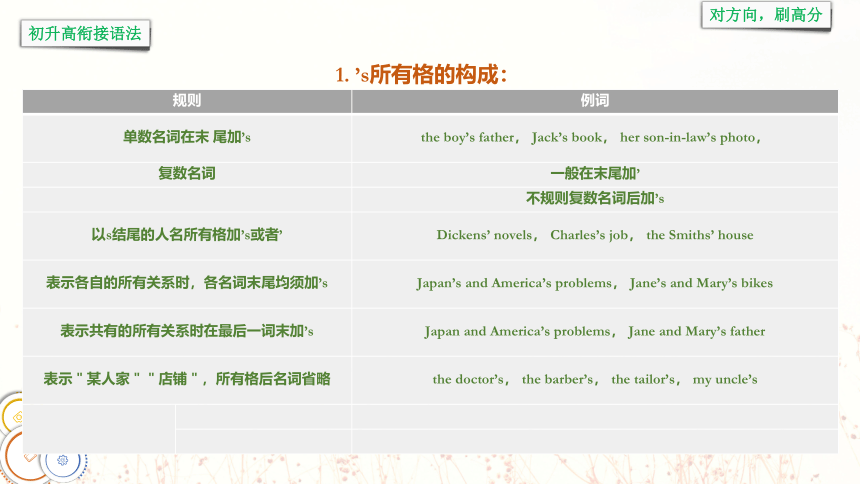
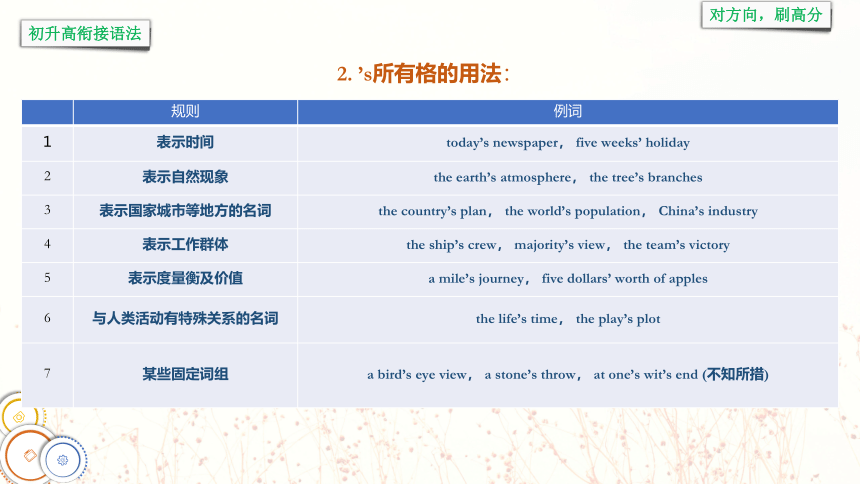
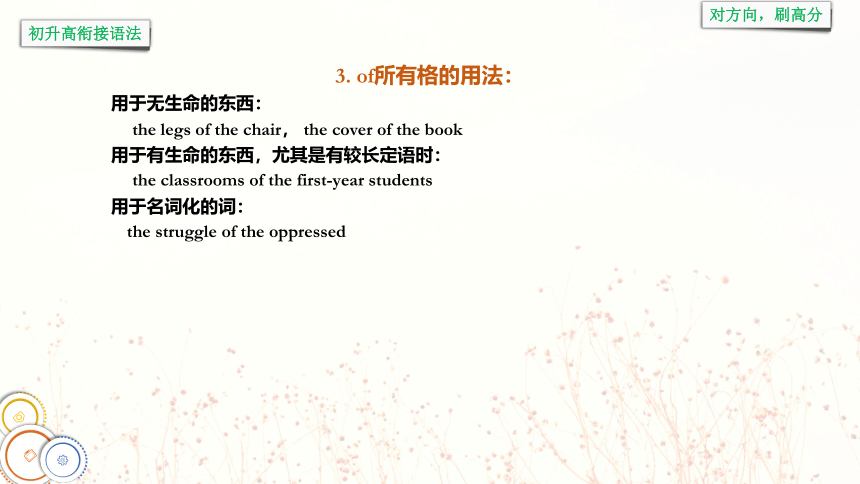
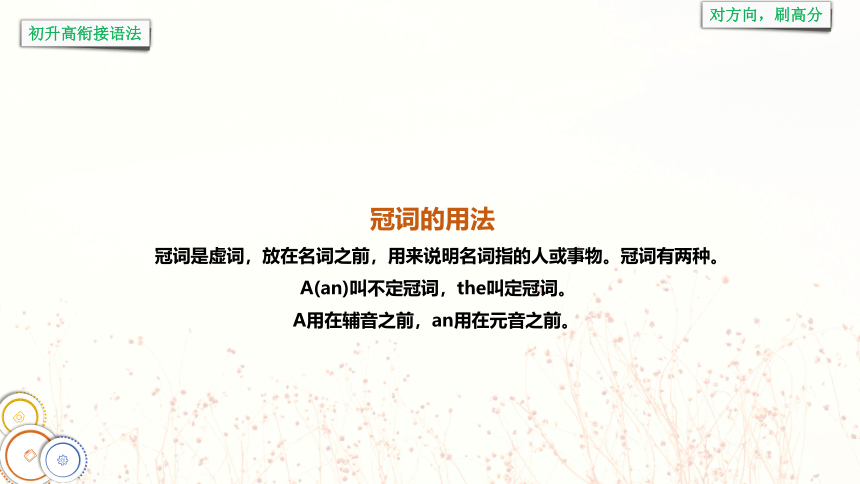
文档简介
(共22张PPT)
解析名词,冠词和数词
1.名词
I. 名词的种类:
专有名词 普通名词
国名地名人名,团体机构名称 可数名词 不可数名词
个体名词 集体名词 抽象名词 物质名词
II. 名词的数:
1. 规则名词的复数形式:名词的复数形式,一般在单数形式后面加-s或-es。现将构成方法与读音规则列表如下:
规则 例词
1 一般情况在词尾加-s map-maps, sea-seas, girl-girls, day-days
2 以s , x, ch, sh结尾的名词后加-es class-classes, box-boxes, watch-watches, dish-dishes
3 以-f或-fe结尾的词 变-f和-fe为v再加-es leaf-leaves, thief-thieves, knife-knives,
wife-wives, half-halves
加-s chief-chiefs, proof-proofs, roof-roofs
4 以辅音字母加y结尾的名词,变y为i加-es party-parties, family-families, story-stories, city-cities
5 以元音字母加y结尾的名词,或专有名词以y结尾的,加-s toy-toys, boy-boys, day-days, ray-rays, Henry-Henrys
6 以辅音字母加-o结尾的名词 一般加-es Negro-Negroes, hero-heroes, potato-potatoes, tomato-tomatoes
不少外来词加-s piano-pianos, photo-pho tos, auto-autos, kilo-kilos, solo-solos
两者皆可 zero-zeros/zeroes, volcano-volcanoes/ volcanos
7 以元音字母 加-o结尾的名词加-s radio-radios, bamboo-bamboos, zoo-zoos
8 以-th结尾的名词加-s truth-truths, mouth-mouths, month-months, path-paths,
II. 不规则名词复数:英语里有些名词的复数形式是不规则的,现归纳如下:
规则 例词
1 改变名词中的元音字母或其他形式 man-men, woman-women, foot-feet, goose-gees e, mouse-mice
2 单复数相同 sheep, deer, means, works, fish, yuan, jin,
3 只有复数形式 trousers, clothes, thanks, goods, glasses,
4 一些集体名词总是用作复数 people, police
5 部分集体名词既可以作单数(整体)也可以作复数(成员) class, family, crowd, couple, group, government, population, team, public, party
6 复数形式表示特别含义 customs(海关), times(时代), spirits(情绪), drinks(饮料), sands(沙滩), papers(文件报纸), looks(外表), brains(头脑智力), greens(青菜)
7 表示“某国人” 加-s Americans, Australians, Germans, Greeks, Swedes, Europeans
单复数同形 Swiss, Portuguese, Chinese, Japanese
以-man或-woman结尾的改为-men,-women English men, Frenchwomen
8 合成名词 将主体名词变为复数 sons-in-law, lookers-on, passers-by, story-tellers, boy friends
无主体名词时将最后一部分变为复数 grown-ups, housewives, stopwatches
将两部分变为复数 women singers, men servants
III. 名词的所有格:
名词在句中表 示所有关系的语法形式叫做名词所有格。所有格分两种:
一是名词词尾加’s构成,二是由介词of加名词构成。
前者多表示有生命的东西,后者多表示无生命的东西。
1. ’s所有格的构成:
规则 例词
单数名词在末 尾加’s the boy’s father, Jack’s book, her son-in-law’s photo,
复数名词 一般在末尾加’
不规则复数名词后加’s
以s结尾的人名所有格加’s或者’ Dickens’ novels, Charles’s job, the Smiths’ house
表示各自的所有关系时,各名词末尾均须加’s Japan’s and America’s problems, Jane’s and Mary’s bikes
表示共有的所有关系时在最后一词末加’s Japan and America’s problems, Jane and Mary’s father
表示"某人家""店铺",所有格后名词省略 the doctor’s, the barber’s, the tailor’s, my uncle’s
2. ’s所有格的用法:
规则 例词
1 表示时间 today’s newspaper, five weeks’ holiday
2 表示自然现象 the earth’s atmosphere, the tree’s branches
3 表示国家城市等地方的名词 the country’s plan, the world’s population, China’s industry
4 表示工作群体 the ship’s crew, majority’s view, the team’s victory
5 表示度量衡及价值 a mile’s journey, five dollars’ worth of apples
6 与人类活动有特殊关系的名词 the life’s time, the play’s plot
7 某些固定词组 a bird’s eye view, a stone’s throw, at one’s wit’s end (不知所措)
3. of所有格的用法:
用于无生命的东西:
the legs of the chair, the cover of the book
用于有生命的东西,尤其是有较长定语时:
the classrooms of the first-year students
用于名词化的词:
the struggle of the oppressed
冠词的用法
冠词是虚词,放在名词之前,用来说明名词指的人或事物。冠词有两种。
A(an)叫不定冠词,the叫定冠词。
A用在辅音之前,an用在元音之前。
1. 不定冠词的用法
(1) a和an均用在单数名词之前,表示某一类人或事物。例如:
John is a student.
Mary is an English teacher.
(2) 指某一类人或事物中的任何一个。例如:
A steel worker makes steel.
Pass me an apple, please.
(3) 指某人或某物,但不具体说明何人或和物。例如:
A student wants to see you.
A girl is waiting for you outside.
(4) 表示“每一”的意思,相当于every。例如:
Take the medicine three times a day.
They go to see their parents once a week.
2. 定冠词用法
(1) 特指某(些)人或某(些)事物。例如:
The book on the desk is an English dictionary.
Beijing is the capital of China.
(2) 指说话人和听话人都熟悉的人或事物。例如:
Open the door, please.
Jack is in the library.
(3) 上文提到过的人或事物。例如:
Yesterday John’s father bought him a new bike. The bike cost him 200 yuan.
(4) 表示世界上独一无二的事物。例如:
The sun rises in the east and sets in the west.
(5) 用在序数词和形容词最高级之前。例如:
Shanghai is the biggest city in China.
January is the first month of the year.
(5) 用在序数词和形容词最高级之前。例如:
Shanghai is the biggest city in China.
January is the first month of the year.
(6) 用在某些形容词之前,表示某一类 人或事物。例如:
The nurse is kind to the sick.
We should take good care of the old.
(7) 用在某些专有名词之前和某些习惯用语中。例如:
the Great Wall, the Summer palace, in the morning,
in the open air等。
(8) 用在姓氏复数之前,表示“某某一家人”,“某某夫妇”。例如:
the Browns, the whites等。
3. 不用冠词的情况
(1) 某些专有名词,抽象名词和物质名词前一般不用冠词。例如:
China, Canada, Japanese, glass, water, love等。
(2) 名词前已有作定语用的this, that, my, your, whose, some, any, no, each, every等代词时,不用冠词。例如:
That is my cap.
I have some questions.
Go down this street.
(3) 复数名词表示一类人或事物时,不用冠词。
They are workers.
We are students.
(4) 称呼语前不用冠词,表示头衔和职务的名词前也不加冠词。例 如:
I don’t feel well today, Mother.
Bush was made president of the U.S.
数词的用法
数词分基数词和序数词。基数词表示数目,序数词表示顺序。
1. 基数词的用法
(1) 基数词在句中主要用作主语、宾语、定语、表语、同位语,例如:
Thirty of them are Party members.(主语)
--- How many would you like?
--- Three ,please.(作宾语)
The nine boys are from Tianj ing.(定语)
Six plus four is ten.(表语)
We four will go with you.(同位语)
(2) 表示一个具体数字时,hundred, thousand, million一律不用复数;在表示一个不确定数字时则用复数。例如:
Our country has a population of 1,300 million people.
There are three thousand students in our school.
After the war, thousands of people became homeless.
Maize is the most important food crop for millions of people in the world.
They arrived in twos and threes.
(3) 表示“……十”的数词的复数形式可用来表示人的岁数或年代,例如:
He is in his early thirties.
He died still in his forties.
This took place in the1930s.(4) 表示时刻用基数词。例如:
We get up at six.
The workers begin work at eight.
(5) 三餐饭的名称前,球类活动,学科和节目名词前,常不用冠词。例如:
I have lunch at home.
He often plays football after class.
We have English and maths every day.
(6) 在某些固定词组里,名词之前常不用冠词。例如:
By air, at night, at home, go to bed, go to school, on foot,
from morning till night 等。
(5) 表示“几点过几分”,用介词past,但须在半小时以内。例如:
ten past ten,
a quarter past nine,
half past twelve
(6) 表示“几点差几分”用介词to, 但分数须在半小时以上。例如:
twenty to nine,
five to eight,
a quarter to ten
(7) 表示“几点几分”还可直接用基数词。例如:
seven fifteen,
eleven thirty,
nine twenty
2. 序数词的用法
(1)序数词主要用作定语,前面要加定冠词,例如:
The first truck is carrying a foot baskets.
John lives on the fifteenth floor.
(2)序数词有时前面可加不定冠词来表示“再一”,“又一”这样的意思,例如:
We‘ll have to do it a second time.
Shall I ask him a third time?
When I sat down,a fourth man rose to speak.
(3)由几个序数词和基数词在拼写时不对应,很容易写错,应特别注意。它们是:one---first, two---second, three---third, five---fifth, eight---eighth, nine---ninth, twelve---twelfth。
(4)表示年,月,日时, 年用 基数词表示,日用序数词表示。例如:
1949年十月一日读作: October (the) first, nineteen sixty
2004年九月十日读作:September (the) tenth, two thousand and four
(5)表示分数时,分子用基数词表示,分母用序数词表示。分子大于1时,分母加-s。例如:
three fourths,
one second,
two fifths
(6)序数词有时用缩写形式:
first→1stsecond→2nd
third→3rdfourth→4th
twenty-second→22nd
1. This morning I had ________ egg and a bottle of milk for my breakfast.
A. an B. a C. the D./
2. ---What’s the matter with you
---I caught ________ bad cold and had to stay in ________.
A. a;/ B. a; the C. a; a D. the; the
3. ---Have you seen _______ pen I left it here this morning.
---Is it ___ _____ black one I think I saw it somewhere.
A. a; the B. the; the C. the; a D. a;
4. _______ sun is shining brightly.
A. A B. An C. The D. /
5. There is _______ “h” in the word hour.
A. a B. the C. an D./
【演练】
1.A
2.A
3.D
4.C
5.C
6. Did you enjoy your stay in Xian
Yes. I had _______ wonderful time.
A. a B. an C. the D.
7. ______ sun is bigger than _______ earth.
A. A; the B. A; an C. T he; an D. The; the
8. There is _______ apple and some pears on the table.
A. the B./ C. a D. an
9. David has _______ cat. It’s very nice.
A. a B. an C. the D./
10. I’m reading _______ novel. It is _______ interesting story.
A. a; an B. a; a C. the; the D. /; an
【演练】
6.A
7.D
8.D
9.A
10.A
11. It is said that SARS has killed more than ________ people worldwide.
A. three hundreds B. three hundreds’
C. three hundred’s D. three hundred
12. ---How many workers are there in your factory
---There are two __________.
A. hundreds B. hundred C. hundred of D. hundreds of
13. ---Which is the smallest number of the four
---_______________.
A. Two-thirds B. A half C. A quarter D. Three-fourths
14. ---What do you think of a war, Li Ming
---I’ve no idea. But it’s a fact that _______ people had to leave their hometown during
the War on Iraq.
A . three thousands B. thousand of
C. thousands of D. several thousands
15. We all think that the _______ century will bring us more hopes.
A. twenty-first B. twentieth-first
C. twenty-one D. twentieth-one
【演练】
11.D
12.B
13.C
14.C
15. A
16. ---Can you write the number eighty-five thousand, six hundred and twenty-six
---Yes, it is __________.
A. 856620 B. 85626 C. 58662 D. 58626
17. When was the PRC founded It was founded on _________.
A. July 1, 1921 B. October 1, 1949
C. August 1, 1927 D. May 1, 1922
18. I was 8 years old when my father was 31. This year my father is twice my age. How
old am I
A. 21 B. 22 C. 23 D. 24
19. _______ Chinese are looking for ways to learn English well before Beijing 2008
Olympics.
A. Thousand B. Thousands C. Thousand of D. Thousands of
20. Both of the two rulers are broken. I want to buy a _______one.
A. three B. third C. forth D. /
【演练】
16.B
17.B
18.C
19.D
20.B
解析名词,冠词和数词
1.名词
I. 名词的种类:
专有名词 普通名词
国名地名人名,团体机构名称 可数名词 不可数名词
个体名词 集体名词 抽象名词 物质名词
II. 名词的数:
1. 规则名词的复数形式:名词的复数形式,一般在单数形式后面加-s或-es。现将构成方法与读音规则列表如下:
规则 例词
1 一般情况在词尾加-s map-maps, sea-seas, girl-girls, day-days
2 以s , x, ch, sh结尾的名词后加-es class-classes, box-boxes, watch-watches, dish-dishes
3 以-f或-fe结尾的词 变-f和-fe为v再加-es leaf-leaves, thief-thieves, knife-knives,
wife-wives, half-halves
加-s chief-chiefs, proof-proofs, roof-roofs
4 以辅音字母加y结尾的名词,变y为i加-es party-parties, family-families, story-stories, city-cities
5 以元音字母加y结尾的名词,或专有名词以y结尾的,加-s toy-toys, boy-boys, day-days, ray-rays, Henry-Henrys
6 以辅音字母加-o结尾的名词 一般加-es Negro-Negroes, hero-heroes, potato-potatoes, tomato-tomatoes
不少外来词加-s piano-pianos, photo-pho tos, auto-autos, kilo-kilos, solo-solos
两者皆可 zero-zeros/zeroes, volcano-volcanoes/ volcanos
7 以元音字母 加-o结尾的名词加-s radio-radios, bamboo-bamboos, zoo-zoos
8 以-th结尾的名词加-s truth-truths, mouth-mouths, month-months, path-paths,
II. 不规则名词复数:英语里有些名词的复数形式是不规则的,现归纳如下:
规则 例词
1 改变名词中的元音字母或其他形式 man-men, woman-women, foot-feet, goose-gees e, mouse-mice
2 单复数相同 sheep, deer, means, works, fish, yuan, jin,
3 只有复数形式 trousers, clothes, thanks, goods, glasses,
4 一些集体名词总是用作复数 people, police
5 部分集体名词既可以作单数(整体)也可以作复数(成员) class, family, crowd, couple, group, government, population, team, public, party
6 复数形式表示特别含义 customs(海关), times(时代), spirits(情绪), drinks(饮料), sands(沙滩), papers(文件报纸), looks(外表), brains(头脑智力), greens(青菜)
7 表示“某国人” 加-s Americans, Australians, Germans, Greeks, Swedes, Europeans
单复数同形 Swiss, Portuguese, Chinese, Japanese
以-man或-woman结尾的改为-men,-women English men, Frenchwomen
8 合成名词 将主体名词变为复数 sons-in-law, lookers-on, passers-by, story-tellers, boy friends
无主体名词时将最后一部分变为复数 grown-ups, housewives, stopwatches
将两部分变为复数 women singers, men servants
III. 名词的所有格:
名词在句中表 示所有关系的语法形式叫做名词所有格。所有格分两种:
一是名词词尾加’s构成,二是由介词of加名词构成。
前者多表示有生命的东西,后者多表示无生命的东西。
1. ’s所有格的构成:
规则 例词
单数名词在末 尾加’s the boy’s father, Jack’s book, her son-in-law’s photo,
复数名词 一般在末尾加’
不规则复数名词后加’s
以s结尾的人名所有格加’s或者’ Dickens’ novels, Charles’s job, the Smiths’ house
表示各自的所有关系时,各名词末尾均须加’s Japan’s and America’s problems, Jane’s and Mary’s bikes
表示共有的所有关系时在最后一词末加’s Japan and America’s problems, Jane and Mary’s father
表示"某人家""店铺",所有格后名词省略 the doctor’s, the barber’s, the tailor’s, my uncle’s
2. ’s所有格的用法:
规则 例词
1 表示时间 today’s newspaper, five weeks’ holiday
2 表示自然现象 the earth’s atmosphere, the tree’s branches
3 表示国家城市等地方的名词 the country’s plan, the world’s population, China’s industry
4 表示工作群体 the ship’s crew, majority’s view, the team’s victory
5 表示度量衡及价值 a mile’s journey, five dollars’ worth of apples
6 与人类活动有特殊关系的名词 the life’s time, the play’s plot
7 某些固定词组 a bird’s eye view, a stone’s throw, at one’s wit’s end (不知所措)
3. of所有格的用法:
用于无生命的东西:
the legs of the chair, the cover of the book
用于有生命的东西,尤其是有较长定语时:
the classrooms of the first-year students
用于名词化的词:
the struggle of the oppressed
冠词的用法
冠词是虚词,放在名词之前,用来说明名词指的人或事物。冠词有两种。
A(an)叫不定冠词,the叫定冠词。
A用在辅音之前,an用在元音之前。
1. 不定冠词的用法
(1) a和an均用在单数名词之前,表示某一类人或事物。例如:
John is a student.
Mary is an English teacher.
(2) 指某一类人或事物中的任何一个。例如:
A steel worker makes steel.
Pass me an apple, please.
(3) 指某人或某物,但不具体说明何人或和物。例如:
A student wants to see you.
A girl is waiting for you outside.
(4) 表示“每一”的意思,相当于every。例如:
Take the medicine three times a day.
They go to see their parents once a week.
2. 定冠词用法
(1) 特指某(些)人或某(些)事物。例如:
The book on the desk is an English dictionary.
Beijing is the capital of China.
(2) 指说话人和听话人都熟悉的人或事物。例如:
Open the door, please.
Jack is in the library.
(3) 上文提到过的人或事物。例如:
Yesterday John’s father bought him a new bike. The bike cost him 200 yuan.
(4) 表示世界上独一无二的事物。例如:
The sun rises in the east and sets in the west.
(5) 用在序数词和形容词最高级之前。例如:
Shanghai is the biggest city in China.
January is the first month of the year.
(5) 用在序数词和形容词最高级之前。例如:
Shanghai is the biggest city in China.
January is the first month of the year.
(6) 用在某些形容词之前,表示某一类 人或事物。例如:
The nurse is kind to the sick.
We should take good care of the old.
(7) 用在某些专有名词之前和某些习惯用语中。例如:
the Great Wall, the Summer palace, in the morning,
in the open air等。
(8) 用在姓氏复数之前,表示“某某一家人”,“某某夫妇”。例如:
the Browns, the whites等。
3. 不用冠词的情况
(1) 某些专有名词,抽象名词和物质名词前一般不用冠词。例如:
China, Canada, Japanese, glass, water, love等。
(2) 名词前已有作定语用的this, that, my, your, whose, some, any, no, each, every等代词时,不用冠词。例如:
That is my cap.
I have some questions.
Go down this street.
(3) 复数名词表示一类人或事物时,不用冠词。
They are workers.
We are students.
(4) 称呼语前不用冠词,表示头衔和职务的名词前也不加冠词。例 如:
I don’t feel well today, Mother.
Bush was made president of the U.S.
数词的用法
数词分基数词和序数词。基数词表示数目,序数词表示顺序。
1. 基数词的用法
(1) 基数词在句中主要用作主语、宾语、定语、表语、同位语,例如:
Thirty of them are Party members.(主语)
--- How many would you like?
--- Three ,please.(作宾语)
The nine boys are from Tianj ing.(定语)
Six plus four is ten.(表语)
We four will go with you.(同位语)
(2) 表示一个具体数字时,hundred, thousand, million一律不用复数;在表示一个不确定数字时则用复数。例如:
Our country has a population of 1,300 million people.
There are three thousand students in our school.
After the war, thousands of people became homeless.
Maize is the most important food crop for millions of people in the world.
They arrived in twos and threes.
(3) 表示“……十”的数词的复数形式可用来表示人的岁数或年代,例如:
He is in his early thirties.
He died still in his forties.
This took place in the1930s.(4) 表示时刻用基数词。例如:
We get up at six.
The workers begin work at eight.
(5) 三餐饭的名称前,球类活动,学科和节目名词前,常不用冠词。例如:
I have lunch at home.
He often plays football after class.
We have English and maths every day.
(6) 在某些固定词组里,名词之前常不用冠词。例如:
By air, at night, at home, go to bed, go to school, on foot,
from morning till night 等。
(5) 表示“几点过几分”,用介词past,但须在半小时以内。例如:
ten past ten,
a quarter past nine,
half past twelve
(6) 表示“几点差几分”用介词to, 但分数须在半小时以上。例如:
twenty to nine,
five to eight,
a quarter to ten
(7) 表示“几点几分”还可直接用基数词。例如:
seven fifteen,
eleven thirty,
nine twenty
2. 序数词的用法
(1)序数词主要用作定语,前面要加定冠词,例如:
The first truck is carrying a foot baskets.
John lives on the fifteenth floor.
(2)序数词有时前面可加不定冠词来表示“再一”,“又一”这样的意思,例如:
We‘ll have to do it a second time.
Shall I ask him a third time?
When I sat down,a fourth man rose to speak.
(3)由几个序数词和基数词在拼写时不对应,很容易写错,应特别注意。它们是:one---first, two---second, three---third, five---fifth, eight---eighth, nine---ninth, twelve---twelfth。
(4)表示年,月,日时, 年用 基数词表示,日用序数词表示。例如:
1949年十月一日读作: October (the) first, nineteen sixty
2004年九月十日读作:September (the) tenth, two thousand and four
(5)表示分数时,分子用基数词表示,分母用序数词表示。分子大于1时,分母加-s。例如:
three fourths,
one second,
two fifths
(6)序数词有时用缩写形式:
first→1stsecond→2nd
third→3rdfourth→4th
twenty-second→22nd
1. This morning I had ________ egg and a bottle of milk for my breakfast.
A. an B. a C. the D./
2. ---What’s the matter with you
---I caught ________ bad cold and had to stay in ________.
A. a;/ B. a; the C. a; a D. the; the
3. ---Have you seen _______ pen I left it here this morning.
---Is it ___ _____ black one I think I saw it somewhere.
A. a; the B. the; the C. the; a D. a;
4. _______ sun is shining brightly.
A. A B. An C. The D. /
5. There is _______ “h” in the word hour.
A. a B. the C. an D./
【演练】
1.A
2.A
3.D
4.C
5.C
6. Did you enjoy your stay in Xian
Yes. I had _______ wonderful time.
A. a B. an C. the D.
7. ______ sun is bigger than _______ earth.
A. A; the B. A; an C. T he; an D. The; the
8. There is _______ apple and some pears on the table.
A. the B./ C. a D. an
9. David has _______ cat. It’s very nice.
A. a B. an C. the D./
10. I’m reading _______ novel. It is _______ interesting story.
A. a; an B. a; a C. the; the D. /; an
【演练】
6.A
7.D
8.D
9.A
10.A
11. It is said that SARS has killed more than ________ people worldwide.
A. three hundreds B. three hundreds’
C. three hundred’s D. three hundred
12. ---How many workers are there in your factory
---There are two __________.
A. hundreds B. hundred C. hundred of D. hundreds of
13. ---Which is the smallest number of the four
---_______________.
A. Two-thirds B. A half C. A quarter D. Three-fourths
14. ---What do you think of a war, Li Ming
---I’ve no idea. But it’s a fact that _______ people had to leave their hometown during
the War on Iraq.
A . three thousands B. thousand of
C. thousands of D. several thousands
15. We all think that the _______ century will bring us more hopes.
A. twenty-first B. twentieth-first
C. twenty-one D. twentieth-one
【演练】
11.D
12.B
13.C
14.C
15. A
16. ---Can you write the number eighty-five thousand, six hundred and twenty-six
---Yes, it is __________.
A. 856620 B. 85626 C. 58662 D. 58626
17. When was the PRC founded It was founded on _________.
A. July 1, 1921 B. October 1, 1949
C. August 1, 1927 D. May 1, 1922
18. I was 8 years old when my father was 31. This year my father is twice my age. How
old am I
A. 21 B. 22 C. 23 D. 24
19. _______ Chinese are looking for ways to learn English well before Beijing 2008
Olympics.
A. Thousand B. Thousands C. Thousand of D. Thousands of
20. Both of the two rulers are broken. I want to buy a _______one.
A. three B. third C. forth D. /
【演练】
16.B
17.B
18.C
19.D
20.B
